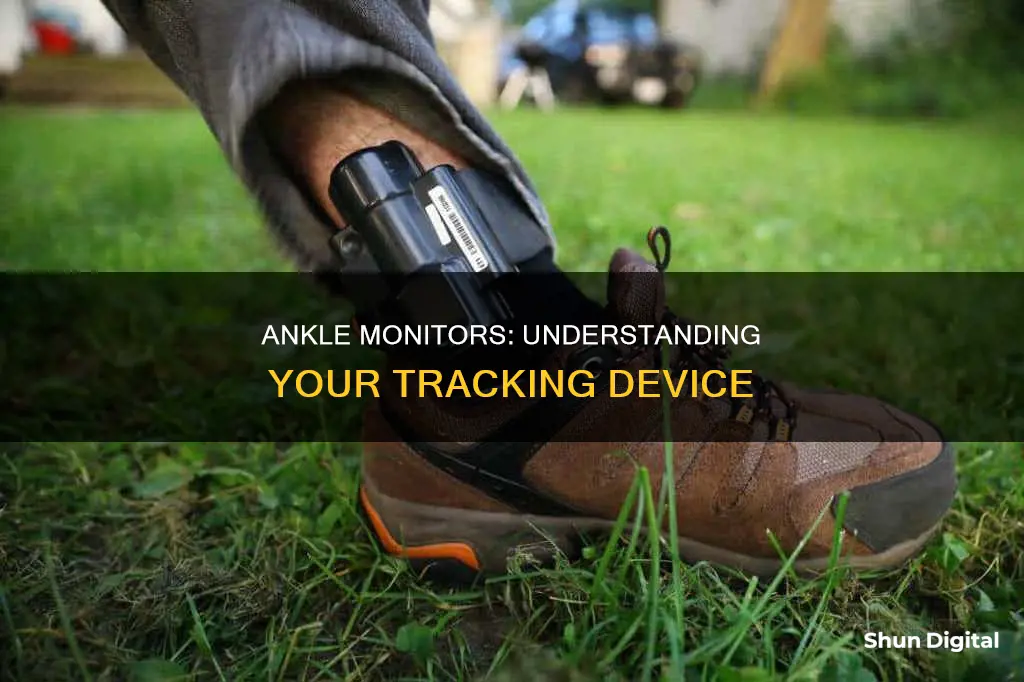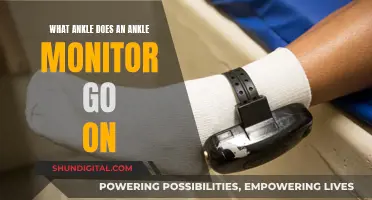
Ankle monitors are a form of surveillance that tracks an individual's movements and location using GPS technology. They are often used as an alternative to traditional imprisonment, allowing individuals to serve their sentences while remaining in the community. Ankle monitors are typically used for individuals on probation or parole, or those awaiting trial. They can also be used for low-risk individuals convicted of a crime who are not considered a danger to the community. While ankle monitors offer advantages such as reduced costs and the ability for individuals to maintain their jobs and support their families, they also come with disadvantages, including discomfort, skin irritation, and strict rules that, if violated, can result in additional penalties.
| Characteristics | Values |
|---|---|
| Size | About the size of a pager |
| Attachment | Strapped to the ankle with a tamper-proof band |
| Type of monitoring | Radio frequency (RF) |
| Tracking system | GPS |
| Signal transmission | Transmits a signal to a base unit, usually located in the home and connected to a landline phone |
| Alert | Vibrates and emits a loud tone if the wearer goes outside the designated area |
| Alert for authorities | Sends an alert if the wearer doesn't return to the designated area |
| Installation | Requires a company to install the monitor |
| Cost | Daily GPS fees, which vary from firm to firm |
| Waterproof | Yes |
| Airport security | Not permitted |
| Weight | Fairly lightweight |
What You'll Learn

How much do ankle monitors cost?
The cost of an ankle monitor can vary depending on several factors, including the type of device, the company providing the service, and the user's income.
The cost to install an ankle monitor typically ranges from $50 to $100. Additionally, there is a daily monitoring fee, which can range from as little as $5 per day to as much as $40 per day. For people on a low income, the court may pay for the system.
For example, the private monitoring company EMASS charges $10 per day for their services, while cities often pay private contractors a much lower rate of $2 to $3 per day for the same equipment and services.
It's important to note that the costs associated with ankle monitors don't just include the device and monitoring fees. There can also be miscellaneous costs, such as the requirement of a landline phone, which can add extra expenses for the person wearing the device. If the tracking component of the device is lost or damaged, there will also be a cost to the wearer.
In addition to the financial cost, there is also a significant personal cost to wearing an ankle monitor. The devices can cause skin irritation and psychological distress, impacting the wearer's daily life and employment prospects.
Finding Hertz: Monitor Refresh Rates Simplified
You may want to see also

Who uses ankle monitors?
Ankle monitors are typically used for individuals who are on probation or parole, awaiting trial, or have been convicted of a crime but are considered low-risk and not a danger to the community. They are often used as an alternative to traditional imprisonment, allowing individuals to serve their sentences while remaining in the community and maintaining their jobs, education, and family lives.
In the state of Indiana, for example, ankle monitors are commonly used as a condition of probation, which is itself a common alternative to incarceration. Offenders are offered probation when their crimes do not warrant jail time and they would be better served by remaining in the community under supervision and adhering to specific conditions.
Ankle monitors are also used for those who have shown signs of substance abuse issues. For instance, a Secure Continuous Remote Alcohol Monitor (SCRAM) bracelet can detect alcohol in a person's sweat, alerting authorities if the wearer violates the terms of their release by drinking.
In addition, ankle monitors can be used to monitor sex and violent offenders, and those on bail or awaiting trial.
Easy Speaker Setup: Element Monitor and Desktop Edition
You may want to see also

How do ankle monitors work?
Ankle monitors, also known as ankle bracelets, ankle shackles, or tethers, are a form of electronic tagging used for surveillance. They are typically used on people awaiting trial, serving probation or parole, or facing immigration proceedings. The use of ankle monitors has been on the rise, with a 140% increase in active monitors between 2005 and 2015. During the COVID-19 pandemic, their use further expanded as jurisdictions sought alternatives to incarceration to slow the spread of the disease.
Ankle monitors typically use GPS tracking systems to record the wearer's location. This information is transmitted to a monitoring company or authority, such as the police or the National Probation Service. The data can be sent via a landline connection or through the mobile phone system. In some cases, radio frequency technology may be used for short-range monitoring.
Ankle monitors can be used to enforce curfews and restrict how long a person can stay outside and where they can go. They may also be equipped with additional features, such as alcohol monitoring, which samples the wearer's perspiration every 30 minutes to detect alcohol consumption.
Ankle monitors are designed to be difficult to remove without detection. They typically have a fiber optic cable that runs through the strap and connects to a box on both sides. If the fiber optic connection is interrupted, it triggers a tamper alert. Additionally, the monitor must be properly fitted to the wearer's ankle to prevent removal.
While ankle monitors are intended to support rehabilitation and ensure public safety, there are concerns about their effectiveness and impact on wearers. Studies have shown that they may contribute to mass incarceration, leading to jail time for minor technical violations, charging malfunctions, and false alarms. They can also exacerbate systemic inequities, with higher rates of monitoring among certain racial and socioeconomic groups. The stigma, social isolation, and stress associated with ankle monitors can negatively affect the mental health of wearers.
TV or Monitor: Which Should You Buy?
You may want to see also

What are the rules for wearing an ankle monitor?
Ankle monitors are often used as an alternative to incarceration, allowing individuals to remain free while awaiting trial or serving their sentences. However, wearing an ankle monitor comes with a set of rules and restrictions that individuals must follow to avoid legal consequences. Here are the key rules for wearing an ankle monitor:
Restrictions on Movement and Location
One of the primary rules of wearing an ankle monitor is the restriction on movement and location. Ankle monitors with GPS or radio frequency technology are used to track the wearer's location, ensuring they abide by court-ordered movement restrictions. The permitted distance and specific areas that the individual can travel to are determined by a judge and are based on the needs of the wearer and the reason for the monitor. In most cases, individuals on house arrest are not permitted to leave their designated home address. If they attempt to do so, the ankle monitor will alert the wearer and notify the authorities.
In some cases, individuals may be allowed to travel outside their homes for specific reasons, such as work, religious services, medical appointments, or court-ordered appointments. These travels are usually restricted to specific times and must be scheduled in advance so that the monitoring authorities are aware of the wearer's whereabouts.
Regular Check-Ins and Reporting
Individuals on ankle monitors are typically required to regularly check in with their probation or parole officers at scheduled times. They may also be subject to random drug testing, home visits, and face-to-face office visits as part of their supervision conditions.
Abstaining from Drugs and Alcohol
Another important rule for individuals on ankle monitors is abstaining from drugs and alcohol. In some cases, the ankle monitor is capable of detecting alcohol consumption by analyzing the wearer's sweat. This feature is crucial for enforcing restrictions on individuals with alcohol-related offenses, such as driving under the influence (DUI).
No Tampering or Removal
Ankle monitors are locked in place to prevent tampering or removal. They are designed with built-in sensors that notify authorities if the wearer attempts to remove or interfere with the device. In some jurisdictions, such as Florida, the removal or attempted removal of an ankle monitor is considered a felony offense.
Compliance with Court Orders
Overall, the most critical rule for wearing an ankle monitor is strict compliance with the court's orders and the conditions of supervision. Failure to comply with these rules can result in serious consequences, including arrest, stricter monitoring terms, revocation of parole, and potential jail time.
Setting Up Studio Monitors and Sub: A Comprehensive Guide
You may want to see also

What happens if you break the rules?
Ankle monitors are used as a way to track someone's location and are often used as a substitute for harsher penalties, such as incarceration. They are typically worn by those on house arrest, probation, or parole, and can be used to monitor those awaiting trial, serving probation, or facing immigration proceedings.
If you break the rules of your ankle monitor, there can be serious consequences. In Florida, for example, tampering with or attempting to remove an ankle monitor is considered a third-degree felony, which can result in up to 5 years in prison and a fine of up to $5,000. Additionally, this conviction can count towards a habitual offender status, which could enhance the penalty to up to 10 years in prison.
Even if you did not intentionally try to remove or alter the ankle monitor, you could still be arrested. The police are notified of any changes to the monitor, and you could be arrested for doing something even if you did not intend to violate the rules.
Breaking the rules of your ankle monitor can also result in more strict monitoring terms, revocation of parole, and jail time. It is important to understand the rules and potential consequences of violations to maintain your future freedom and quality of life.
Turning Off Timer on Your ASUS ROG Swift Monitor
You may want to see also
Frequently asked questions
An ankle monitor is a device worn around the lower leg to track the movements of individuals who have been sentenced to restricted travel or activities.
Ankle monitors use GPS technology to track the wearer's location and can be set up to vibrate and emit a loud tone if the wearer goes outside a designated area.
People awaiting trial, serving probation or parole, or facing immigration proceedings may be required to wear an ankle monitor. It is also used for people with substance abuse issues or as a condition of bail.
The rules depend on the individual's situation but may include sticking to a specific area, avoiding certain people, or adhering to a curfew.
If you attempt to remove your ankle monitor, it will trigger an alert and you may face additional penalties, including jail time.







